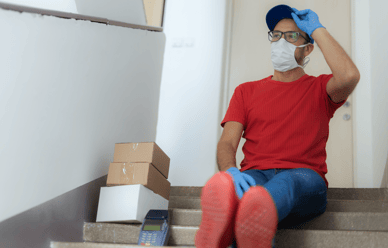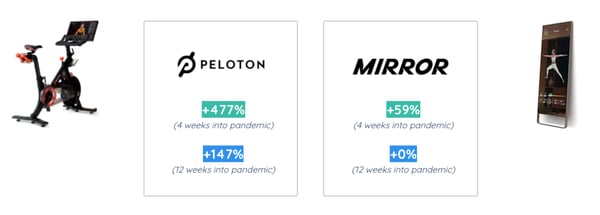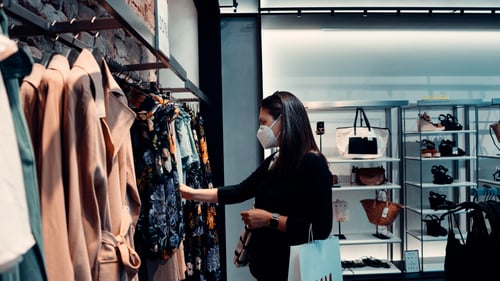In-store browsing is on pause in much of the country.
Yes, this reality has been accelerated by concerns around COVID-19 exposure. But, even before we entered the upside-down world of 2020, consumers were making decisions online regardless of whether or not they completed the purchase in-store.
As the customer journey moves further online, how do you create digital experiences that facilitate that entire process, from discovery to long after the purchase?
Our CEO, Florian Kahlert, sat down with Chris Gilmartin, the Founder and President of our partner Lever Interactive, to discuss these shifts and the ways companies can lean into them.

Here are some of the themes that emerged, which we’ll dive into below:
-
- To grab attention and earn consideration, we need to build better digital experiences
- This desire for experience doesn’t end at the point of purchase, so companies will need to figure out how to create a more engaging and interactive product experience
- A deep understanding of your audience is the key to making those experiences resonate in an authentic way
“People go to the store, make the purchase decision, and get the hell out”
In the past, e-retailers like Amazon benefitted from showrooming, where customers would go to a big-box store and try the product out before buying it for cheaper online.
Now, we’re seeing a reversal where customers are using digital channels for the research and discovery stages before heading into a store to quickly purchase the product. Some retailers are even providing online product listings that help consumers spend less time searching in the physical location.
“Even when they still buy eventually at the store, a lot more is probably going to happen online, outside the store — outside the confines of what they're currently used to on the manufacturing side,” Kahlert said.
“I speak for more of my own experience right now...‘Oh, it's available in my store in aisle 11, bay 17.’”
 SOURCE: Home Depot
SOURCE: Home Depot
Because of these dual shifts, there is more pressure than ever to elevate these at-home retail experiences to match what is available in physical stores, with an emphasis on the elements that help customers make their purchase decisions.
In the words of Kahlert, “people are going to the store, making the purchase decision, and getting the hell out.”
“Most retailers with roots in brick-and-mortar simply try to replicate their in-store experience online, but such efforts are fruitless and misguided,” Denise Lee Yohn wrote for Harvard Business Review. “Beyond the transaction basics discussed earlier, customers don’t expect a virtual experience to be like an in-person one — nor do they want it to be.”
To successfully shift your retail operation online, you need to understand the most sorely missed aspects of your in-store experience and fill in those gaps using the internet’s unique benefits.
“Life is still gonna be okay if I don't have it tomorrow”
All of this becomes easier and more effective when people are on your website, instead of Amazon or another marketplace. You have full control over the experience and gather invaluable first-party data to optimize every stage of the process.
“Those relationships may have to go further down into the purchase cycle because of things that...can really have an impact and things that are out of their control when it comes to delivery of these products to their customers,” Gilmartin said.
“I wonder if there will be a movement towards other online retailers. I think, in my own experience and sort of polling unscientifically, as people were dealing with shortages and things like that, there were definitely people stepping out of their Amazon bubble.”
To continue moving the needle away from Amazon’s retail operation, e-retailers are going to need to continue creating superior online shopping experiences that are tailored to their products and the process their customers go through to reach a purchase decision.

"Actually they broke us of the habit," Kahlert said. With delays in shipping and production, we haven't been expecting the things we purchase to show up on our doorsteps two days later.
“And it's okay. Life is still gonna be okay if I don't have it tomorrow, and I think that actually might be able to help what you're pointing out, in terms of other companies having more of a chance.”
“Even boomers know how to Zoom at this point”
Video content will continue to play a big role in creating engaging experiences for retailers.
“We've seen realtors do virtual tours for a long time,” Gilmartin said. “I'm very excited to see what creative ways industries are gonna leverage that”
 SOURCE: Dennis Leupold for Savage X Fenty/Amazon Prime Video
SOURCE: Dennis Leupold for Savage X Fenty/Amazon Prime Video
And few virtual retail experiences were more engaging and creative than the current quarantine gold standard: Rihanna’s new Savage X Fenty Show Vol. 2, which recently debuted on Prime Video.
For the second year in a row, Rihanna managed to create a fresh take on television home shopping with the cultural impact of an iconic fashion show and a sense of urgency that demanded appointment viewing.
That works for a mass-media approach to products requiring less consideration, but Gilmartin thinks certain industries could create more personalized experiences that leverage the accelerated adoption of video conferencing.
“Bring customers into these types of live Zoom-based experiences where they can ask more direct questions, they can see products and ways that they maybe wouldn't be able to see otherwise,” Gilmartin said. “I think this is definitely gonna work its way into a lot of brand experience, especially on the higher-end items and things where there's more consideration.”
The shift would be even easier for brands like Best Buy, as an example, who rebuilt their empire through a focus on customer experience and direct service.
“There's definitely great potential,” Kahlert said, “because, yeah, even boomers know how to Zoom at this point.”
“Positioning your products or services as a gateway to a meaningful experience”
The utility of virtual experiences in retail extends well beyond the point of purchase. More and more, brands are using technology to engage customers and keep them coming back for more.
“One of the tenets that we've proven out time and time again is...positioning your products or services as a gateway to a meaningful experience,” Gilmartin said, drawing from experiences with Lever Interactive and its sister agency Coming of Age, which focuses on seniors.
“Because of what we’re seeing with the pandemic, consumers are going to shift their dollars more towards experiences rather than material things, regardless of their age.”
“Travel is going to be an anxious experience for a while,” Kahlert said, “so, what can brands do to provide an experience,” especially as people are stuck working, living, and sleeping in the same space, in many cases.
“This is what the Mirror and the Peloton people actually tapped into, almost accidentally, and accelerated during COVID: Providing this mix of experience but at a safe distance,” Kahlert said. “So it's not just a piece of exercise equipment. It is actually an experience and a way of doing things that is very different”
And our analysis of COVID-19 trends, Helixa @ Home, highlights this. The digital adoption section, specifically, shows how people leaned on digital experiences to get through the initial weeks of quarantine. While both Mirror and Peloton saw growth in the first four weeks after March 11, only Peloton was able to sustain that growth.

SOURCE: Helixa @ Home
This experiential element of physical products is really interesting, because you have the same product sitting in your living room every day, but each new morning it holds new experiences that have been downloaded from the cloud.
The success of brands like Peloton could signal a dramatic change in the way we imagine our physical products. Perhaps the Millennial dilemma between material objects and experiences doesn’t have to have such a clear divide.
“I need to feel like they’re speaking my language”
But for these experiences to be successful — both in leading up to the purchase and in using the actual product — brands need to understand their customers and prospects in a much more deep and meaningful way.
“It's that mentality of really trying to understand where their clients are, where their customers are headed, their interests, what their needs are — and as those change, helping to satisfy those needs,” Gilmartin said. “We've seen a real difference in those clients who do that and those who are working their way towards that.”
“You need to know what kind of things they're into, in order to really create experiences that matter to them,” according to Kahlert. “And I think the marketers that do that, ultimately they do better, and we see that those marketers that use us for this kind of stuff, they win more business… the outcomes are speaking for themselves.”
The Savage X Fenty show was a great example of this. Rihanna’s team understood the type of experience the audience was looking for, the kinds of music they liked, and the people who influence them.
Then they brought it all together to turn the usual fashion show tropes into something unique and unforgettable.
There’s also the matter of recency and the urgency it can create. The Savage X Fenty event was huge, and you will often need those audience insights quickly. Helixa can tap into that conversation to let you know who is discussing the show and what else they care about.
“Going back to some of the important data that (Helixa is) providing us, in terms of what people are talking about, what they're trending...paying much closer attention to that is gonna be more critical now than it ever was,” Gilmartin said.
Agreeing with Gilmartin, Kahlert adds, “It's not just stuff that I buy. I need to be aligned with what that brand represents. I need to be aligned with what philosophy that brand has...and I need to feel like they’re speaking my language.”
“Listen and change as things are changing”
As consumers continue to shift more of their purchase decisions online — even when buying in-store — it will become essential to create experiences that measure up. And this goes beyond just elevating each stage of the customer journey, which has always and will always be relevant.
It’s critical that you lean into the current retail realities we are facing and use them as an opportunity to innovate. You want to solve for the sorely missed elements of physical retail (which may never return to “normal”) in a way that sets you apart from the crowd.

Some brands, like Savage X Fenty, have the opportunity to create buzz through their experiences. For the rest of us, it’s still a matter of showing up where your consumers are, at those key moments, with the right message.
That’s where companies like Helixa and Lever Interactive can help. Helixa can provide deep insight into what your audience cares about, so you can make important decisions with more confidence. And Lever Interactive can use that data to maximize the effectiveness of your online marketing, helping you grow your business and build your future.
“When we talk to clients and prospects, it's like, ‘Don't look at your feet. Look three months, six months forward,’” Kahlert said, “because you want to make sure that you are ready when things turn around.”
“I think clients that we have worked with over the years, who have done that, are doing better now,” Gilmartin said. “They're doing better because of the understanding they have of their clients — their willingness to listen and change as things are changing.”
--------------

Savage X Fenty Show Vol. 2 — Analysis
This analysis includes lessons in retail experiences that all marketers can learn from this iteration of the fashion show, including examples from smaller brands and original Helixa data. Grab your copy below.
 Ryan is the Marketing Communications Manager at Helixa, where he leads content strategy from the NYC office. He believes in a lot of things, but never ghosts, guilty pleasures, or his Florida Gators’ offense.
Ryan is the Marketing Communications Manager at Helixa, where he leads content strategy from the NYC office. He believes in a lot of things, but never ghosts, guilty pleasures, or his Florida Gators’ offense.






